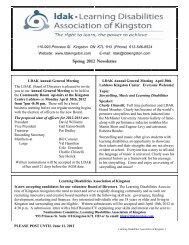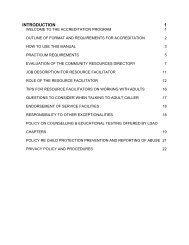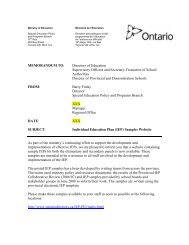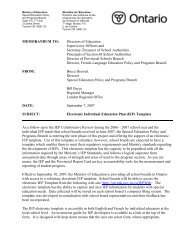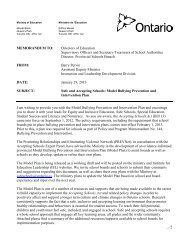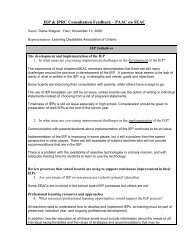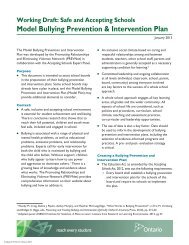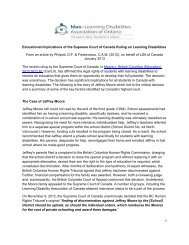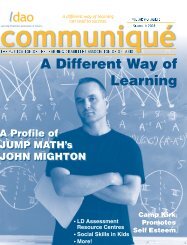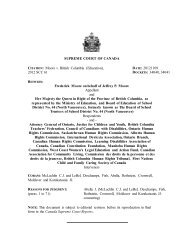LDAO Fall 2002.pdf - Learning Disabilities Association of Ontario
LDAO Fall 2002.pdf - Learning Disabilities Association of Ontario
LDAO Fall 2002.pdf - Learning Disabilities Association of Ontario
You also want an ePaper? Increase the reach of your titles
YUMPU automatically turns print PDFs into web optimized ePapers that Google loves.
Advocacy for Adolescents<br />
Training teens to take on their own troubles<br />
Advocacy <strong>of</strong>ten appears to be a parent’s<br />
job. It seems to fall under the category<br />
<strong>of</strong> protection-protecting one’s young from<br />
harm, from failure. Indeed, for the primary<br />
school youngster, the parent is his or her<br />
most important and passionate advocate.<br />
But once a child reaches junior high or high<br />
school, most parents are automatically<br />
disqualified from advocacy. The fact that<br />
they are parents (and are, therefore,<br />
inherently “uncool” and, quite possibly,<br />
incapable in their teenager’s eyes) is the<br />
element that dismisses them from this role.<br />
Who then becomes a youngster’s<br />
champion? The youngster her or himself.<br />
The very ones who, in the end, must<br />
understand and accept their disability, and,<br />
who must act proactively to seek solutions<br />
that make a difference. That is why, as<br />
parents and caring pr<strong>of</strong>essionals, one <strong>of</strong> our<br />
most important goals should be to help the<br />
child with ADD and/or <strong>Learning</strong><br />
<strong>Disabilities</strong> develop into an informed and<br />
effective self-advocate.<br />
Student self-advocacy can begin<br />
successfully by grades four/five. Indeed,<br />
many youngsters with ADD and/or LD<br />
possess an incredible verbal fluency and<br />
social sophistication that are invaluable<br />
assets in negotiation. Those words “overly<br />
social” and “gregarious”, which heret<strong>of</strong>ore<br />
have appeared on report cards as negatives,<br />
now can be recognized as strengths and<br />
brought to bear for the student’s own<br />
benefit.<br />
The steps in training youngsters as selfadvocates<br />
are identical to those used in<br />
training their parents.<br />
1. Identify the student’s individual<br />
strengths as a learner.<br />
2. Identify what his or her liabilities are<br />
and how these affect classroom<br />
performance.<br />
3. Identify and request reasonable<br />
accommodations in testing and<br />
instruction.<br />
Students who engage in this advocacy<br />
training must be mature and secure enough<br />
to accept their differences, as well as<br />
believe in and maximize their strengths.<br />
The development <strong>of</strong> a student “Self-<br />
Advocacy Worksheet” must be done<br />
utilizing the student’s own words, words<br />
which he or she will be comfortable usingultimately<br />
by him or her self- in<br />
negotiation. Advocacy worksheets differ in<br />
length and sophistication depending on the<br />
age <strong>of</strong> the child. The single most important<br />
element in successful student selfadvocacy<br />
is that the student can selfexamine,<br />
self-accept and (through support<br />
and practice) become self-sufficient in this<br />
process.<br />
A student who is developing advocacy<br />
skills must learn the concrete preparatory<br />
steps to negotiation:<br />
1. Don’t go up and try to advocate before<br />
or after class.<br />
2. Make an appointment with the teacher.<br />
3. Write the date and time on your<br />
worksheet.<br />
4. Have copies <strong>of</strong> your worksheet for<br />
everyone who will be there.<br />
5. Review your worksheet before your<br />
meeting.<br />
6. Arrive on time.<br />
Attitude check-negotiation NOT<br />
confrontation:<br />
The training <strong>of</strong> a student as a self-advocate<br />
must include role-playing and rehearsal. At<br />
Educational Tutoring and Consulting, we<br />
develop the worksheet as an exercise in<br />
self-realization, self-acceptance and selfempowerment.<br />
We utilize the worksheet as<br />
a guide-a game plan-for the student to<br />
follow in advocacy meetings with his or her<br />
teacher(s). We recommend that the<br />
worksheet be put in the teacher’s mailbox<br />
prior to the first meeting.<br />
The coordinator working with the student<br />
role-plays advocacy sessions prior to<br />
meeting with the teacher and accompanies<br />
the student to the first in-school advocacy<br />
session. She acts as an initiator, the one<br />
who models the first step (that critical step<br />
that so eludes our youngsters): “Mr.<br />
Jamieson, Brett has developed a thoughtful<br />
plan for participating successfully in your<br />
classroom. He would like to present it to<br />
you and work with you in developing some<br />
solutions for him as a student. Brett-”.<br />
Sample Advocacy Worksheet<br />
6th. Grade Student<br />
Strengths:<br />
1. I am good at expressing myself verbally.<br />
2. I am very artistic (with watercolours).<br />
3. I have good computer skills.<br />
<strong>Learning</strong> Differences:<br />
1. Attention Deficit Disorder<br />
2. Language: Phonetic Memory (spelling)<br />
3. Written expression (on demand)<br />
What Happens to Me<br />
in the Classroom:<br />
1. I have a hard time with the organization<br />
and pacing <strong>of</strong> long-term assignments.<br />
2. I cannot screen out environmental<br />
stimuli like outside movement or a<br />
ticking clock.<br />
3. I sometimes have a short fuse, and I<br />
<strong>of</strong>ten react impulsively.<br />
4. I have a difficult time taking notes.<br />
What Would Help Me<br />
in the Classroom:<br />
1. Chunk long-term assignments. Ask for<br />
these “chunks” on a daily/weekly basis.<br />
2. Balance lectures with visual delivery:<br />
charts, timelines, mind maps etc.<br />
3. Give me an outline <strong>of</strong> the lecture in<br />
advance.<br />
4. Give me a reading guide before I start.<br />
5. Let me demonstrate my knowledge.<br />
6. Modify my testing procedures (more<br />
time/oral tests).<br />
7. Allow someone to take notes for me<br />
(using carbonless paper).<br />
By Janice Bleakney and Karen<br />
Wiles, Educational Testing and<br />
Consulting, Mercer Island, WA.<br />
Reprinted with permission from<br />
CHADDER Box, January, 1994.<br />
FALL 2002, PAGE 8




